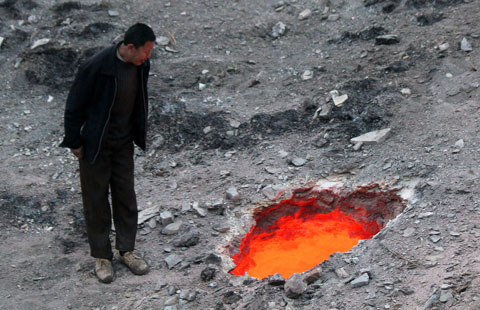Amur tigers come back from the brink
Updated: 2015-04-10 08:12
By Su Zhou(China Daily)
|
||||||||
|
 Volunteers follow their guide through Dongfanghong Forestry Farm in Heilongjiang to remove poachers' traps. [Photo/Xinhua] |
Human withdrawal
Officials in Jilin and Heilongjiang have vowed to enhance the protection of tigers, leopards and the environment.
Jilin has banned commercial logging, to boost the recovery of wood resources and wildlife habitats, and will also "establish three to five nature reserves to protect Amur tigers and their habitats," as well as gradually form a tiger protection network on Changbai Mountain, according to Lan Hongliang, director of the provincial forestry authority.
Wang Jihui, deputy director of the Suiyang county forestry bureau, in Heilongjiang, described his authority's policy as "tigers advance, people withdraw".
Many residents of Suiyang have already been moved out of key protection zones since the establishment of nature reserve and the banning of commercial logging. Although it has cause financial loss, Wang said it was necessary. Employees at forestry farms have adjusted their work from logging to wildlife protection.
"Tigers need space," Wang said. "And as our environment keeps improving, we can attract more tigers from Russia."
A national protection plan is expected soon. In March, Zhao Shucong, director of the State Forestry Administration, called the tigers a working priority and said China is cooperating with regional authorities, as well as university and academy experts, to formulate a strategy.
"China is going to conduct a national survey of wild tigers to provide a base for research and management," he said.
Chang Youde, a senior officer for WWF China's Asian big cats program, said the Amur tiger is an "umbrella species" whose survival indirectly protects many other animals in its habitat. "Protecting tigers is protecting other wildlife," he added.
Just like Chinese and Russian tourists, increasing numbers of Amur tigers are crossing the border, and according to the WWF, a fourth corridor used by migrating animals has recently been identified.
Shi at WWF China said the route runs through Xiaoxinganling Mountain, in northeast Heilongjiang, and along the Heilongjiang River, which marks the boundary between China and Russia. Observers spotted the corridor thanks to Kuzya, an Amur tiger released by Russian President Vladimir Putin that traveled south looking for prey.
Russia is conducting its once-in-a-decade census of Siberian tigers, with 2,000 people searching for signs of the animal in the country's far east. The Russian government hopes to show the numbers in the wild have risen from 450 in 2005 to 600, according to The Guardian newspaper.
"The size of the population in Russia means that the Siberian tigers have reached saturation point," Chang said. "The construction of corridors provides opportunities for tigers to migrate to China."

 Guns prepared to mark Anti-Fascist War anniversary
Guns prepared to mark Anti-Fascist War anniversary
 Tibetans' viral wedding photos contrast city with country life
Tibetans' viral wedding photos contrast city with country life
 Strange but true: Three times a lady
Strange but true: Three times a lady
 Road to Cuba
Road to Cuba
 Trending: 'Gateway to hell' found in Urumqi
Trending: 'Gateway to hell' found in Urumqi
 Last batch of Chinese peacekeeping infantry arrives in S.Sudan
Last batch of Chinese peacekeeping infantry arrives in S.Sudan
 With high property prices, is it OK to rent forever?
With high property prices, is it OK to rent forever?
 Top 7 glass producers in China
Top 7 glass producers in China
Most Viewed
Editor's Picks

|

|

|

|

|

|
Today's Top News
US, Cuba hold highest-level talks since 1961
UN official praises new website that engages Chinese public
Hillary Clinton expected to announce presidential run soon
Shooting outside Washington DC leaves 1 injured
Blocking of chip exports could backfire: scientist
US to help China fight tough TB strain
Rush for H-1B visas is on
Tibetan lawmaker meets US Rep
US Weekly

|

|







